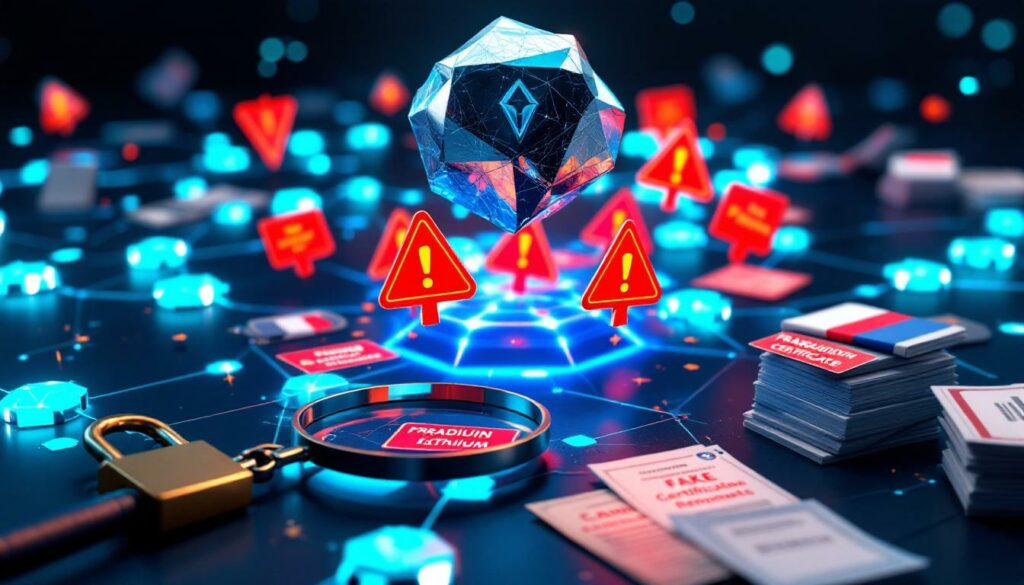What Is Mineral Tokenization and How Should It Work?
The Legitimate Concept of Digital Asset Tokenization
Tokenization represents a transformative approach to investment, converting rights to physical assets into blockchain-based digital tokens. At its core, this technology allows for fractional ownership of valuable resources that might otherwise remain inaccessible to average investors. When implemented legitimately, mineral tokenization can democratize access to commodity investments while providing mining companies with alternative funding sources.
"Tokenization of assets is the process of converting rights over a physical asset into a digital token recorded on a blockchain," explains Fabio Casarín, a geologist and mining law attorney familiar with the emerging space. "This allows buyers to acquire portions of mineral reserves without needing to purchase entire mining operations."
The theoretical promise is compelling: investors gain exposure to strategic commodities like lithium without massive capital requirements, while mining companies access liquidity without surrendering complete ownership of their assets. This approach potentially solves liquidity challenges in an industry where mineral exploration importance can reach billions but remain difficult to divide.
The Specific Application to Mineral Resources
Legitimate mineral tokenization requires several foundational elements that many fraudulent projects deliberately obscure. First, the issuing company must possess verifiable mining rights to the specific property being tokenized. These rights must be documented through official mining registries and accessible for investor verification.
Second, professional resource estimates prepared by qualified persons (under standards like JORC, NI 43-101, or SAMREC) must substantiate any claims about mineral quantities. These reports provide crucial third-party verification that the claimed resources actually exist and have been properly quantified.
Third, transparent redemption mechanisms must be established so token holders understand exactly what their tokens represent and how they can be converted to value. This might include physical delivery options, profit-sharing arrangements, or buyback programs tied to production milestones.
Finally, proper regulatory compliance is essential. Mineral-backed tokens typically qualify as securities in most jurisdictions, requiring appropriate registrations and disclosures to operate legally. Legitimate operators embrace these requirements rather than attempting to circumvent them.
Why Has Lithium Become a Target for Tokenization Schemes?
The Strategic Importance of Lithium in Modern Technology
Lithium has emerged as the "white gold" of the clean energy transition, making it an ideal target for tokenization scams. This lightweight metal forms the foundation of modern battery technology, powering everything from smartphones to electric vehicles and grid-scale energy storage systems. Global demand projections show a potential 500% increase by 2050 as EV adoption accelerates and renewable energy storage needs expand.
This explosive growth trajectory creates a compelling investment narrative that scammers readily exploit. With lithium prices experiencing significant volatility—ranging from $8,000 to $78,000 per ton between 2020 and 2025—speculative interest has intensified, particularly among retail investors seeking exposure to the clean energy transition.
Adding to the appeal is lithium's concentrated production landscape. Over 75% of global supplies come from just three countries: Australia, Chile, and Argentina. This geographic concentration creates information asymmetries that fraudsters capitalize on, knowing most investors cannot personally verify claims about remote lithium deposits in South America's "Lithium Triangle."
The Appeal to Retail Investors
The scam with lithium tokenization operates by exploiting retail investors' enthusiasm for green technology investments combined with limited access to traditional lithium exposure. While institutional investors can directly fund mining operations or purchase futures contracts, individual investors typically face high barriers to entry.
Digital tokens marketed as "lithium-backed" appear to solve this access problem by promising fractional ownership of mineral reserves with minimal investment thresholds—often as low as $100. This democratization narrative resonates with investors frustrated by their inability to participate in the green energy revolution through conventional channels.
Scammers further enhance appeal by emphasizing lithium's critical role in combating climate change. By framing investments as both profitable and environmentally responsible, they tap into the growing trend of purpose-driven investing. The combination of potential profits, environmental impact, and technological innovation creates a powerful psychological cocktail that can override normal due diligence processes.
"These operations leverage legitimate interest in strategic minerals with blockchain's perceived trustworthiness," notes Roberto Cacciola, President of the Argentine Chamber of Mining Companies (CAEM). "The technology itself isn't fraudulent, but it's being weaponized to create a false sense of security and verification."
How Do Lithium Tokenization Scams Typically Operate?
Common Deceptive Practices in Mineral Token Offerings
The scam with lithium tokenization follows recognizable patterns that investors should vigilantly monitor. First, fraudulent operators typically claim ownership or development rights to lithium-rich properties in remote regions difficult for investors to physically verify. The Atómico3 case exemplifies this approach, with promoters falsely claiming access to lithium reserves in Argentina's Salar de Mogna.
Second, these schemes grossly exaggerate or completely fabricate resource estimates. While legitimate mining operations require years of exploration, drilling, and independent verification before quantifying resources, scammers skip these critical steps. Instead, they present hypothetical numbers as certified reserves, creating the illusion of established value where none exists.
"They sold tokens supposedly backed by lithium reserves that didn't exist," explains Fabio Casarín. "They had no agreement with the mining rights holder, no exploration drill results, and no certified resources, yet claimed each token represented a specific quantity of lithium."
Third, fraudulent projects establish artificial scarcity to drive up perceived value. By limiting initial token availability while promising future price appreciation, they create FOMO (fear of missing out) that rushes investors into decisions before conducting proper due diligence. This manufactured urgency becomes a powerful tool to override rational investment analysis.
Finally, these operations frequently misrepresent their development timeline, claiming imminent production from properties that haven't even completed preliminary exploration. The disconnect between claimed capabilities and actual development status often reaches absurd proportions, with some projects promising production within months from completely unexplored properties.
The Technical Mechanisms of Deception
The blockchain infrastructure underlying these scams adds technical complexity that further obscures fraudulent activities. One common tactic involves strategic platform-hopping—migrating tokens between different blockchain networks to break the chain of transaction history and complicate tracking efforts.
In the Atómico3 case, the operation migrated tokens between multiple blockchain platforms, diluting investor holdings without consent. "They executed an 8:1 conversion ratio, meaning investors who purchased 8 tokens on the original blockchain received just 1 token after migration," notes Casarín. This dilution technique essentially allows operators to siphon away 87.5% of claimed token value while maintaining technical compliance with their terms.
Another mechanism involves creating artificial trading activity to simulate market interest. By controlling multiple wallets, operators can execute wash trades—transactions between their own accounts—to create the appearance of growing demand and rising prices. This manufactured activity attracts new investors while providing exit liquidity for the operators.
The most sophisticated operations employ multi-layered corporate structures spanning multiple jurisdictions to obscure accountability. A typical arrangement might involve a Swiss foundation owning tokens, a British Virgin Islands company holding mining claims, and a Delaware LLC managing investments—all controlled by the same individuals but legally distinct, complicating recovery efforts when fraud is discovered.
What Are the Warning Signs of Fraudulent Lithium Token Projects?
Red Flags in Project Documentation
Identifying the scam with lithium tokenization requires careful examination of project documentation, where telltale warning signs often appear. The most significant red flag is the absence of verifiable mining permits and exploration licenses. Legitimate mining operations readily provide concession numbers and registration details that can be cross-referenced with official mining cadastres maintained by government authorities.
"No había trabajos, ni recursos, ni un informe que determinara que el salar era un depósito de litio," stated Roberto Cacciola about the Atómico3 case, highlighting that there were no works, resources, or reports confirming lithium deposits at the claimed site. This fundamental absence of documentation should immediately disqualify any investment consideration.
Equally concerning is the lack of qualified person reports on mineral resources. Legitimate mining projects follow established standards like JORC (Australia), NI 43-101 (Canada), or SAMREC (South Africa) that require resource estimates to be prepared and signed by recognized professional geologists or mining engineers. These reports detail exploration methods, sampling procedures, and statistical confidence in the findings—all absent in fraudulent offerings.
Vague geographic descriptions present another warning sign. While legitimate projects provide precise coordinates and property boundaries, fraudulent schemes often resort to general regional references ("located in the Lithium Triangle") or misleading proximity claims ("adjacent to major producing mines"). This deliberate imprecision prevents straightforward verification.
Finally, watch for missing or contradictory information about the connection between token issuers and mining property owners. Legitimate tokenization requires clear legal agreements between the token issuer and the actual holder of mining rights, often through binding contracts that should be available for investor review.
Suspicious Marketing and Promotion Tactics
The marketing approaches employed by fraudulent lithium token projects constitute a second category of warning signs. Most notable are unrealistic promises about guaranteed returns, particularly when framed as "risk-free investments" or with specific percentage guarantees. Legitimate mining investments acknowledge inherent geological, operational, and market risks rather than promising certainty.
High-pressure sales tactics creating artificial urgency represent another red flag. Common phrases like "limited token availability," "pre-sale closing soon," or "special founder prices ending tomorrow" aim to short-circuit due diligence by forcing quick decisions. Legitimate projects welcome thorough investor examination rather than rushing commitment.
Excessive focus on token price appreciation rather than the underlying lithium project should also raise concerns. While legitimate tokenization emphasizes the development pathway from exploration to production, fraudulent projects primarily discuss token trading strategies, exchange listings, and price projections—treating the lithium component as secondary to speculation.
Celebrity endorsements or influencer promotions without substantive mining expertise constitute a growing investment red flags. Scammers increasingly pay social media personalities to promote token offerings, leveraging their audience reach while providing minimal project substance. These promotions typically focus on potential returns rather than operational fundamentals.
"These operations combine legitimate interest in strategic minerals with the perceived trustworthiness of blockchain," notes Casarín. "This technological wrapping creates a false sense of security and verification that can override normal skepticism."
How Can Investors Perform Due Diligence on Mineral Token Offerings?
Essential Verification Steps Before Investing
Protecting yourself from the scam with lithium tokenization requires following a structured due diligence process before committing any funds. The foundation of this process begins with verifying mining rights through official government registries. Most mining jurisdictions maintain publicly accessible cadastral systems where concession ownership can be confirmed. For example, Argentina's provincial mining departments provide online portals where anyone can search properties by name, location, or owner.
Understanding resource classification systems represents a crucial second step. Mining resources are categorized as "measured," "indicated," or "inferred" based on increasing levels of geological confidence. Legitimate projects clearly distinguish between these categories, while fraudulent operations often blur these distinctions or inappropriately claim "reserves" (which require economic feasibility studies) when only preliminary exploration has occurred.
Investors should also verify the credentials of geological experts cited in documentation. Qualified Persons (QPs) who sign resource reports must meet specific professional and experience requirements. Their credentials can be verified through professional associations like the Australasian Institute of Mining and Metallurgy (AusIMM) or the Society for Mining, Metallurgy & Exploration (SME).
The development team's track record deserves equal scrutiny. Legitimate mining projects are led by professionals with verifiable experience in mineral exploration, mine development, or commodities markets. Their professional histories can be verified through LinkedIn, professional publications, and industry association memberships. Be wary of teams whose backgrounds focus exclusively on cryptocurrency or marketing without relevant mining expertise.
Finally, evaluate regulatory compliance status. Legitimate mineral token offerings typically register with securities regulators or explicitly qualify for specific exemptions. Check with entities like Argentina's Comisión Nacional de Valores (CNV), the U.S. Securities and Exchange Commission (SEC), or equivalent authorities in your jurisdiction to confirm proper registration.
Questions to Ask Token Issuers
Engaging directly with token issuers provides another layer of due diligence protection. Begin by requesting specific documentation of mineral rights, including concession numbers, geographic coordinates, and official registration certificates. Legitimate operators will readily provide this information; evasive responses indicate potential fraud.
Ask for independent verification of resource claims through geological reports prepared by qualified professionals. These reports should follow recognized standards (JORC, NI 43-101, SAMREC) and include detailed exploration methodologies, sampling procedures, and statistical analyses. Request the full technical report, not just summaries or excerpts.
Clarify the token redemption mechanism by asking exactly what rights token ownership confers. Legitimate tokenization includes clear paths to value realization, whether through physical delivery options, profit-sharing mechanisms, or buyback programs. Be skeptical of vague promises about "future utility" without specific details.
Inquire about regulatory compliance status, particularly securities registration. Mineral-backed tokens typically qualify as investment contracts under most jurisdictions' securities laws. Ask which regulatory exemptions the offering utilizes if not fully registered, and verify these claims independently with the relevant authorities.
Finally, request details about fund usage and development timelines. Legitimate projects provide transparent budgets showing how investment proceeds will advance exploration and development, with realistic milestones and timeframes. Compare these projections against industry standards for similar projects to identify unrealistic promises.
What Legal Frameworks Apply to Lithium Tokenization?
Securities Regulations and Digital Assets
Understanding the regulatory landscape surrounding lithium tokenization helps investors recognize the scam with lithium tokenization and identify legitimate opportunities. Most mineral-backed tokens qualify as securities under frameworks like the Howey Test in the United States or equivalent standards internationally. These classifications stem from the tokens representing investment contracts where purchasers invest money in a common enterprise with expectations of profits primarily from others' efforts.
This securities classification triggers significant compliance requirements. In Argentina, the National Securities Commission (CNV) requires registration of Virtual Asset Service Providers (PSAVs) under Resolution 994/2022, with specific disclosure obligations for asset-backed tokens. Similarly, the SEC in the United States generally considers mineral-backed tokens as securities requiring registration under the Securities Act of 1933 unless specific exemptions apply.
These registration processes involve comprehensive disclosure requirements including detailed information about the mining project, development team, risk factors, and financial projections. Legitimate operators embrace these requirements rather than attempting to evade them through creative legal interpretations or offshore structures.
"Muchos proyectos fraudulentos intentan eludir regulaciones argumentando que sus tokens son 'utility tokens' sin características de inversión," notes a CNV spokesperson. "Esta distinción raramente aplica a tokens respaldados por minerales, que son inherentemente instrumentos de inversión." (Many fraudulent projects try to circumvent regulations by arguing their tokens are 'utility tokens' without investment characteristics. This distinction rarely applies to mineral-backed tokens, which are inherently investment instruments.)
Mining Sector Regulations Affecting Tokenization
Beyond securities laws, lithium tokenization intersects with complex mining regulations that vary significantly by jurisdiction. Resource reporting standards represent a critical regulatory component. Frameworks like Australia's JORC Code, Canada's NI 43-101, and South Africa's SAMREC Code establish strict requirements for publicly reporting mineral resources and reserves, including verification by qualified professionals with appropriate expertise and experience.
Environmental and social compliance requirements present additional regulatory layers. Legitimate lithium projects must obtain environmental impact approvals, water usage permits, and community consultation agreements before development can proceed. These requirements vary by jurisdiction but typically involve multi-year processes and substantial documentation that should be available for investor review.
Export restrictions may affect token redemption mechanisms, particularly in countries like Argentina that have established strategic mineral policies. Some jurisdictions limit lithium exports or impose special taxes on mineral exports, potentially impacting the economics of token redemption promises. Legitimate projects address these regulatory realities in their documentation rather than ignoring potential complications.
Jurisdictional differences in mining rights structures create further complexity. While some countries operate under "first come, first served" claim systems, others use concession auctions, state-owned enterprises, or mandatory partnership requirements. Understanding these structures is essential for verifying legitimate property rights, as scammers often exploit investor unfamiliarity with foreign mining permitting guide.
"Es fundamental que los inversores comprendan las particularidades de los derechos mineros en cada provincia argentina," advises Casarín. "Las normas varían significativamente entre provincias, creando oportunidades para tergiversaciones." (It's essential that investors understand the particularities of mining rights in each Argentine province. The regulations vary significantly between provinces, creating opportunities for misrepresentations.)
How Are Regulatory Authorities Responding to Tokenization Scams?
Recent Enforcement Actions
Regulatory authorities worldwide have accelerated enforcement actions against the scam with lithium tokenization as these frauds proliferate. Argentina's National Securities Commission (CNV) has taken a particularly active stance following the Atómico3 case, suspending the company's registration as a Virtual Asset Service Provider and filing criminal complaints for potential fraud with estimated investor losses between $500,000 and $2 million.
"Presentamos denuncia penal por posible estafa tras verificar inexistencia de operaciones mineras," stated a CNV spokesperson, confirming the filing of criminal charges after verifying the non-existence of mining operations. This action demonstrates increasing coordination between securities regulators and mining
Ready to Stay Ahead of Major Mineral Discoveries?
Discover investment-changing mineral discoveries as they happen with Discovery Alert's proprietary Discovery IQ model, delivering instant ASX discovery notifications straight to your inbox. Visit the Discovery Alert discoveries page to see how early identification of major mineral finds can generate exceptional returns and start your 30-day free trial today.




